Stepping Stones (Forward Trust) report (HTML version)
Published 25 April 2024
This analysis looked at the reoffending behaviour of 265 men participating in the Stepping Stones programme with Forward Trust. It covers those who began the programme in prison between January and December 2018. The overall results do not show a statistically significant effect on a person’s reoffending behaviour.
The Stepping Stones (Forward Trust) programme works with men and women in prisons in London, the South East and the East of England, who are using substances at harmful or dependent levels. The programme aims to provide individuals with safe coping skills to help manage any symptoms they may experience while cutting down or abstaining from any medications or substances. This analysis only considers males as there were too few females within the cohort to analyse separately.
The headline (regional) analysis in this report measured proven reoffences in a one-year period for a ‘treatment group’ of 265 offenders who received support some time in 2018, and for a much larger ‘comparison group’ of similar offenders who did not receive it. The analysis estimates the impact of the support from Stepping Stones (Forward Trust) on reoffending behaviour.
1. Overall measurements of the treatment and comparison groups
| For 100 typical men in the treatment group, the equivalent of: | For 100 typical men in the comparison group, the equivalent of: |
|---|---|
| 48 of the 100 men committed a proven reoffence within a one-year period (a rate of 48%), 1 man fewer than in the comparison group. | 49 of the 100 men committed a proven reoffence within a one-year period (a rate of 49%). |
| 230 proven reoffences were committed by these 100 men during the year (a frequency of 2.3 offences offences per person), 30 offences fewer than in the comparison group. | 260 proven reoffences were committed by these 100 men during the year (a frequency of 2.6 offences per person). |
| 100 days was the average time before a reoffender committed their first proven reoffence, 9 days earlier than the comparison group. | 110 days was the average time before a reoffender committed their first proven reoffence. |
2. Overall estimates of the impact of the intervention
| For 100 typical men who receive support, compared with 100 similar men who do not: | |
|---|---|
| The number of men who commit a proven reoffence within one year after release could be lower by as many as 7 men, or higher by as many as 5 men. More men would need to be available for analysis in order to determine the direction of this difference. | |
| The number of proven reoffences committed during the year could be lower by as many as 77 offences, or higher by as many as 17 offences. More men would need to be available for analysis in order to determine the direction of this difference. | |
| On average, the time before an offender committed their first proven reoffence could be shorter by as many as 25 days, or longer by as many as 7 days. More men would need to be analysed in order to determine the direction of this difference. |
Please note totals may not appear to equal the sum of the component parts due to rounding.
| ✔ | What you can say about the one-year reoffending rate: |
|---|---|
| “This analysis does not provide clear evidence on whether support from Stepping Stones (Forward Trust) increases or decreases the number of participants who commit a proven reoffence in a one-year period. There may be a number of reasons for this and it is possible that an analysis of more participants would provide such evidence.” | |
| ✖ | What you cannot say about the one-year reoffending rate: |
| “This analysis provides evidence that support from Stepping Stones (Forward Trust) increases / decreases / has no effect on the reoffending rate of its participants.” | |
| ✔ | What you can say about the one-year reoffending frequency: |
| “This analysis does not provide clear evidence on whether support from Stepping Stones (Forward Trust) increases or decreases the number of proven reoffences during a one-year period. There may be a number of reasons for this and it is possible that an analysis of more participants would provide such evidence.” | |
| ✖ | What you cannot say about the one-year reoffending frequency: |
| “This analysis provides evidence that support from Stepping Stones (Forward Trust) increases / decreases / has no effect on the number of proven reoffences committed during a one-year period by its participants.” | |
| ✔ | What you can say about the one-year reoffending rate: |
| “This analysis does not provide clear evidence on whether support from Stepping Stones (Forward Trust) shortens or lengthens the average time to first proven reoffence. There may be a number of reasons for this and it is possible that an analysis of more participants would provide such evidence.” | |
| ✖ | What you cannot say about the one-year reoffending rate: |
| “This analysis provides evidence that support from Stepping Stones (Forward Trust) shortens / lengthens / has no effect on the average time to first proven reoffence for its participants.” |
3. Figure 1: One-year proven reoffending rate after support from Stepping Stones (Forward Trust)
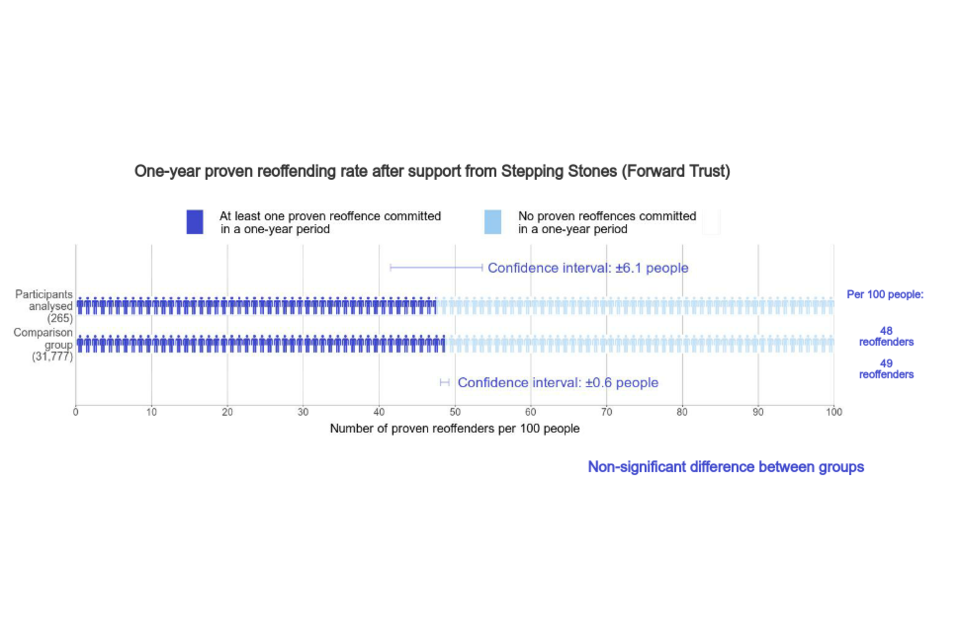
4. Figure 2: One-year proven reoffending frequency after support from Stepping Stones (Forward Trust)
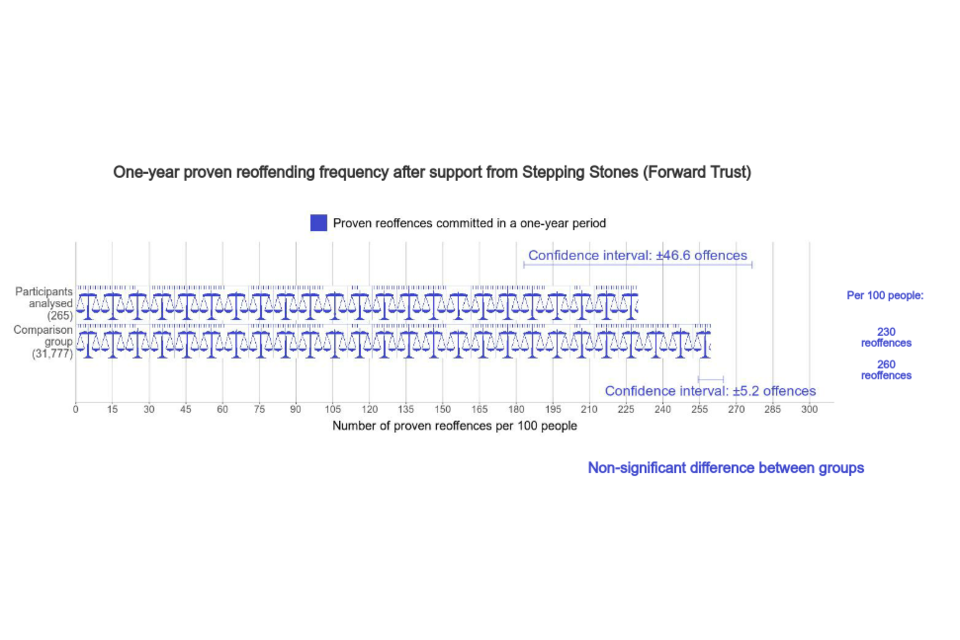
5. Figure 3: Average time (days) to first proven reoffence after support from Stepping Stones (Forward Trust)
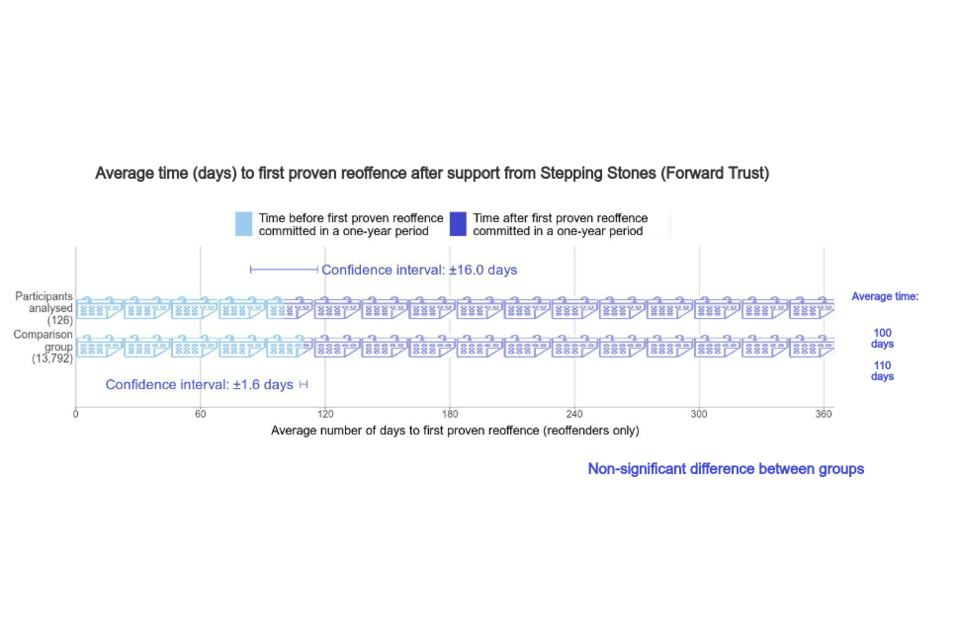
6. Stepping Stones (Forward Trust) in their own words
“ Forward Trust deliver a range of services and interventions in both communities and prisons, aimed at helping people to move forward with their lives. They provide support with substance misuse, family, employment, housing and resettlement, mental health, gambling and probation reforms and offender management. The Stepping Stones programme is a group-based, medium-intensity psychosocial intervention which focuses on learning and practising safe coping mechanisms to manage triggers, cravings and symptoms of trauma. The programme is treated as a ‘stepping stone’ to ongoing, long-term recovery and the content is delivered with the idea of progression in mind, and utilising motivational techniques.
Our client’s journey will differ, as the structure of the programme is designed to allow for flexible delivery, however all clients will participate in the ‘core’ exercises and activities, with the option of participating in extra ‘flexible’ modules. In a custodial setting, it is intended to be delivered as a static, cohort-based programme, with all clients starting and finishing at the same time. After the completion of the Stepping Stones programme, one option may be for clients to progress onto one of Forward Trust’s intensive abstinence-based programmes. ”
7. Response from Stepping Stones (Forward Trust) to the Justice Data Lab analysis
“ We are disappointed that the JDL analysis does not provide clear evidence, one way or the other, of the impact of the Stepping Stones medium-intensity substance misuse programme on re-offending rates or frequency, an analysis based on participant records from 2018. We would welcome the opportunity to increase the number of participants to provide that evidence, recognising the complexities of the control group matching process which led to over half of the initial records submitted being discounted. We also remain committed to working with the JDL and other third parties to evaluate the effectiveness, positive or negative, of our growing range of interventions and programmes delivered in prison and community settings.
Increasingly, Forward Trust is analysing the shorter term, intermediary outcomes and incremental benefits achieved by our programmes and interventions, alongside longer term impact measures such as re-offending. These shorter term measures are particularly relevant for programmes such as Stepping Stones whose primary aim is to develop safe coping mechanisms, and to build motivation for engaging in our more intensive, abstinence-based programmes (separately shown to reduce re-offending). To evaluate this specific aim, a more recent study of Stepping Stones (conducted in 2020 by Forward Trust and based on a revised version of the programme) showed positive outcomes for participants’ resilience, self-efficacy, and general mental health. More detail can be found on the Forward Trust website. ”
8. Results in detail
Two analyses were conducted in total. The headline analysis examined all male participants while the sub-analysis shows the breakdown of results for those who completed the programme. A sub-analysis for those who did not complete the programme was not conducted as there were too few individuals within this cohort to analyse separately. The analysis was conducted controlling for offender demographics and criminal history and the following risks and needs: accommodation, employment history, education, financial history, relationships, drug and alcohol use, mental health, thinking skills and attitudes towards offending.
1. Regional analysis: treatment group matched to offenders in London, South East and East of England using demographics, criminal history and individual risks and needs.
2. Completed Stepping Stones analysis: treatment group matched to offenders in London, South East and East of England using demographics, criminal history and individual risks and needs.
The headline results in this report refer to the regional analysis.
The sizes of the treatment and comparison groups for reoffending rate and frequency analyses are provided below. To create a comparison group that is as similar as possible to the treatment group, each person within the comparison group is given a weighting proportionate to how closely they match the characteristics of individuals in the treatment group. The calculated reoffending rate uses the weighted values for each person and therefore does not necessarily correspond to the unweighted figures.
| Analysis | Controlled for region | Treatment Group Size | Comparison Group Size | Reoffenders in treatment group | Reoffenders in comparison group (weighted number) |
|---|---|---|---|---|---|
| Regional | Yes | 265 | 31,777 | 126 | 13,792 (15,458) |
| Completed | Yes | 201 | 33,176 | 88 | 14,074 (15,448) |
In each analysis, three headline measures of one-year reoffending were analysed, as well as four additional measures (see results in Tables 1-7):
- Rate of reoffending
- Frequency of reoffending
- Time to first reoffence
- Rate of first reoffence by court outcome
- Frequency of reoffences by court outcome
- Rate of custodial sentencing for first reoffence
- Frequency of custodial sentencing
Tables 1-7 show the overall measures of reoffending. Rates are expressed as percentages and frequencies expressed per person. Tables 3 to 7 include reoffenders only.
8.1 Table 1: Proportion of men who committed a proven reoffence in a one-year period (reoffending rate) after support from Stepping Stones (Forward Trust) compared with a matched comparison group
| Analysis | Number in treatment group | Number in comparison group | Treatment group rate (%) | Comparison group rate (%) | Estimated difference (% points) | Significant difference? | p-value |
|---|---|---|---|---|---|---|---|
| Regional | 265 | 31,777 | 48 | 49 | -7 to 5 | No | 0.72 |
| Completed | 201 | 33,176 | 44 | 47 | -10 to 4 | No | 0.43 |
8.2 Table 2: Number of proven reoffences committed in a one-year period (reoffending frequency - offences per person) by men who received support from Stepping Stones (Forward Trust) compared with a matched comparison group
| Analysis | Number in treatment group | Number in comparison group | Treatment group frequency | Comparison group frequency | Estimated difference | Significant difference? | p-value |
|---|---|---|---|---|---|---|---|
| Regional | 265 | 31,777 | 2.30 | 2.60 | -0.77 to 0.17 | No | 0.21 |
| Completed | 201 | 33,176 | 2.35 | 2.38 | -0.59 to 0.54 | No | 0.92 |
8.3 Table 3: Average time (days) to first proven reoffence in a one-year period for men who received support from Stepping Stones (Forward Trust), compared with a matched comparison group
| Analysis | Number in treatment group | Number in comparison group | Treatment group time (days) | Comparison group time (days) | Estimated difference | Significant difference? | p-value |
|---|---|---|---|---|---|---|---|
| Regional | 126 | 13,792 | 100 | 110 | -25 to 7 | No | 0.25 |
| Completed | 88 | 14,074 | 106 | 113 | -27 to 13 | No | 0.48 |
8.4 Table 4: Proportion of men supported by Stepping Stones (Forward Trust) with first proven reoffence in a one-year period (reoffending rate) by court outcome, compared with similar non-participants (reoffenders only)
| Analysis | Number in treatment group | Number in comparison group | Court outcome | Treatment group rate (%) | Comparison group rate (%) | Estimated difference (% points) | Significant difference? | p-value |
|---|---|---|---|---|---|---|---|---|
| Regional | 126 | 13,792 | Either way | 75 | 74 | -7 to 8 | No | 0.93 |
| Summary | 21 | 21 | -8 to 7 | No | 0.86 | |||
| Completed | 88 | 14,074 | Either way | 76 | 76 | -9 to 10 | No | 0.90 |
| Summary | 18 | 20 | -10 to 7 | No | 0.68 |
8.5 Table 5: Number of proven reoffences in a one-year period (reoffending frequency) by court outcome for men supported by Stepping Stones (Forward Trust), compared with similar non-participants (reoffenders only)
| Analysis | Number in treatment group | Number in comparison group | Court outcome | Treatment group frequency | Comparison group frequency | Estimated difference | Significant difference? | p-value |
|---|---|---|---|---|---|---|---|---|
| Regional | 126 | 13,792 | Indictable | 0.18 | 0.09 | -0.09 to 0.28 | No | 0.31 |
| Either way | 3.63 | 3.96 | -1.08 to 0.43 | No | 0.40 | |||
| Summary | 0.94 | 1.17 | -0.46 to 0.00 | No | 0.05 | |||
| Completed | 88 | 14,074 | Indictable | 0.24 | 0.08 | -0.10 to 0.43 | No | 0.23 |
| Either way | 4.00 | 3.82 | -0.79 to 1.14 | No | 0.71 | |||
| Summary | 1.02 | 1.08 | -0.34 to 0.23 | No | 0.71 |
8.6 Table 6: Proportion of men who received a custodial sentence for their first proven reoffence after support from Stepping Stones (Forward Trust), compared with similar non-participants (reoffenders only)
| Analysis | Number in treatment group | Number in comparison group | Treatment group rate (%) | Comparison group rate (%) | Estimated difference (% points) | Significant difference? | p-value |
|---|---|---|---|---|---|---|---|
| Regional | 126 | 13,792 | 54 | 55 | -10 to 8 | No | 0.78 |
| Completed | 88 | 14,074 | 55 | 56 | -12 to 9 | No | 0.78 |
8.7 Table 7: Number of custodial sentences received in a one-year period by men who received support from Stepping Stones (Forward Trust), compared to similar non-participants (reoffenders only)
| Analysis | Number in treatment group | Number in comparison group | Treatment group frequency | Comparison group frequency | Estimated difference | Significant difference? | p-value |
|---|---|---|---|---|---|---|---|
| Regional | 126 | 13,792 | 2.99 | 3.20 | -0.89 to 0.47 | No | 0.55 |
| Completed | 88 | 14,074 | 3.34 | 3.11 | -0.62 to 1.07 | No | 0.60 |
9. Profile of the treatment group
There are a variety of routes by which individuals can be referred to Stepping Stones (Forward Trust), including: self-referral e.g. through induction or via transfer from another prison, through their Offender Manager as part of their sentence plan objectives, via the prison healthcare team or as part of their substance misuse care plan objectives identified during their comprehensive assessment.
| Participants included in analysis (265 offenders) | Participants not included in analysis (399 offenders with available data) | |
|---|---|---|
| Sex | ||
| Male | 100% | 81% |
| Female | 0% | 19% |
| Ethnicity | ||
| White | 80% | 91% |
| Black | 15% | 21% |
| Asian | 4% | 3% |
| Other | 1% | 1% |
| Unknown | 0% | 2% |
| UK national | ||
| UK nationality | 95% | 95% |
| Foreign nationality | 4% | 5% |
| Unknown nationality | 1% | 0% |
| Prison sentence length | ||
| Less than 6 months | 25% | |
| More than 6 months to less than 1 year | 9% | |
| 1 year to less than 4 years | 39% | |
| 4 to 10 years | 23% | |
| More than 10 years | 1% | |
| Imprisonment for public protection | 1% | |
| Mandatory life prisoner | 1% | |
| Other life sentence | 1% |
The individuals in the treatment group were aged 19 to 63 years at the beginning of their one-year period (average age 35).
Information on index offences for the 399 participants not included in the analysis is not available, as they could not be linked to a suitable sentence.
For 18 people, no personal information is available.
Please note totals may not appear to equal the sum of the component parts due to rounding.
Information on individual risks and needs was available for 206 males in the overall treatment group (78%), recorded near to the time of their original conviction. This information is not complete for all 206 males across all risks considered for this analysis, but where it is known for specific risks, some key findings are shown below.
- 94% had some or significant problems with problem solving
- 92% had some or significant problems with impulsivity
- 90% had some or significant problems with the ability to recognise problems
10. Matching the treatment and comparison groups
The analyses matched the treatment group to a comparison group. A large number of variables were identified and tested for inclusion in the regression models. The matching quality of each variable can be assessed with reference to the standardised differences in means between the matched treatment and comparison groups (see standardised differences annex). Over 95% of variables are categorised as green on JDL’s traffic light scale, indicating that the matching quality achieved on the observed variables was very good.
Further details of group characteristics and matching quality, including risks and needs recorded by the Offender Assessment System (OASys), can be found in the Excel annex accompanying this report.
This report is also supplemented by a general annex, which answers frequently asked questions about Justice Data Lab analyses and explains the caveats associated with them.
11. Additional information on the dataset
11.1 Index dates
The index date is the date at which the follow up period for measuring reoffending begins. For individuals participating in Stepping Stones (Forward Trust), the index is the date they are released from custody as the programme was held in prison.
11.2 Participants included in the analysis
The analysis only includes individuals that have been released from prisons where the intervention took place or if they were released into the Government Office Region (GOR) of London, South East or East of England.
12. Numbers of people in the treatment and comparison groups
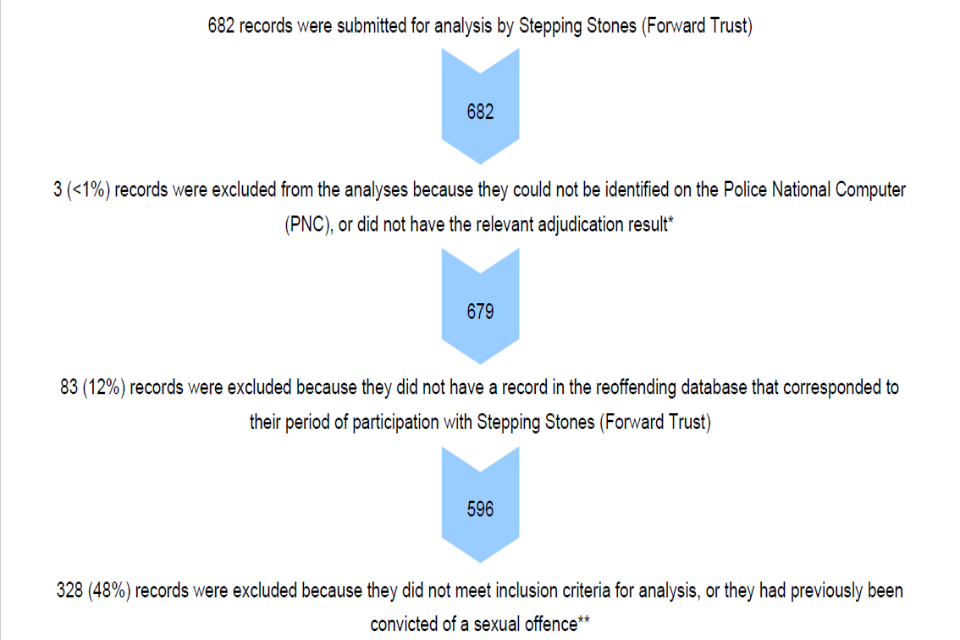
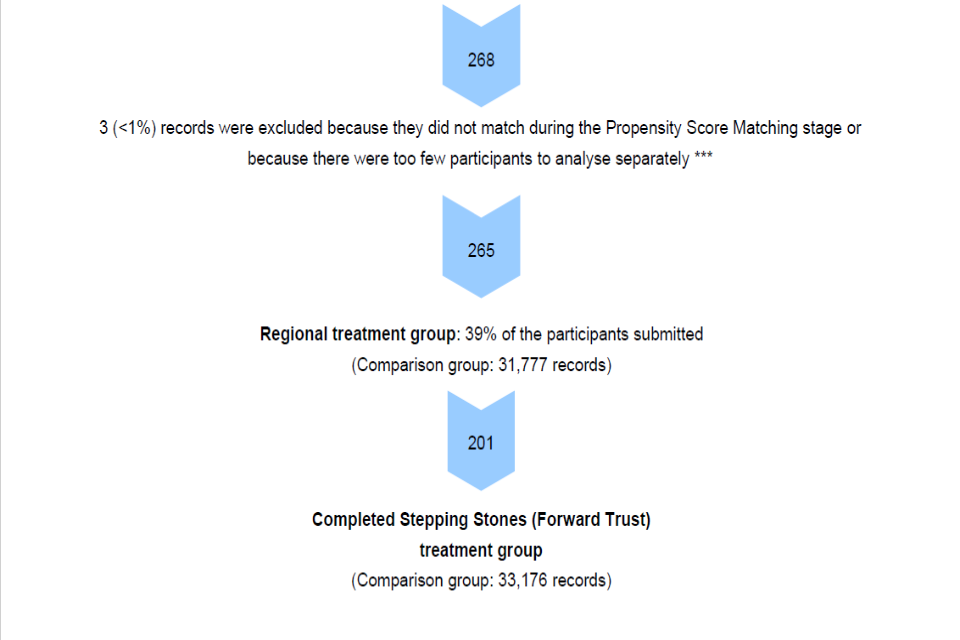
* Adjudication results must be guilty to be considered for analysis, as an individual must have committed an initial offence and have been convicted for it in order for the reoffending rate to be measured.
** Inclusion criteria such as including individuals who have been released from a prison where the intervention took place or if they were released into the Government Office Region (GOR) where the prisons were based.
*** Females were removed from this stage as there were too few females following the propensity score matching stage to analyse separately.
13. Further information
13.1 Official Statistics
Our statistical practice is regulated by the Office for Statistics Regulation (OSR).
OSR sets the standards of trustworthiness, quality and value in the Code of Practice for Statistics that all producers of official statistics should adhere to.
You are welcome to contact us directly with any comments about how we meet these standards.
Alternatively, you can contact OSR by emailing regulation@statistics.gov.uk or via the OSR website.
13.2 Contact
Press enquiries should be directed to the Ministry of Justice press office.
https://www.gov.uk/government/organisations/ministry-of-justice/about/media-enquiries
Other enquiries about the analysis should be directed to:
13.3 Justice Data Lab team
E-mail: justice.datalab@justice.gov.uk
© Crown copyright 2024
Produced by the Ministry of Justice
Alternative formats are available on request from justice.datalab@justice.gov.uk
This document is released under the Open Government Licence
